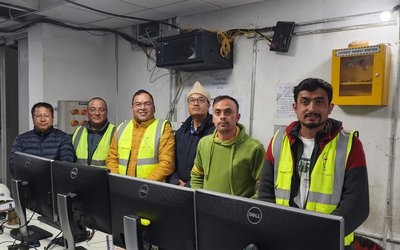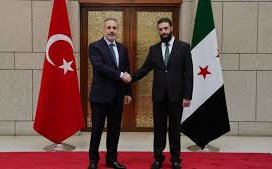
India is ready to build the Dhalkebar-Muzaffarpur 400 kV transmission line with a capacity of 1000 MW. The Indian side is also ready to increase the capacity of this transmission line to 2000 MW, which can exchange 800 MW of electricity.
During the energy secretary level meeting between Nepal and India, Director General of Power Development Department, Chiranjeevi Chatout, announced that they are prepared to increase the energy capacity by exchanging up to 800 MW.
The technical team will oversee the infrastructure necessary to achieve 100 MW. Currently, the capacity of the three transformers is limited to 800 megawatts due to the N minus one criteria, which must also be addressed. With the new transmission line, it will be possible to transmit up to 1000 megawatts of electricity.
The Dhalkebar-Muzaffarpur 400 KV transmission line has a capacity of 2,000 megawatts, but it can currently only import and export 1,000 megawatts due to the 'N minus one' standard. This standard requires one line to be kept in standby in case of a breakdown, resulting in a reduced capacity.
A secretary level meeting was held in Sauraha on Friday. On behalf of Nepal, Energy Secretary Gopal Prasad Sigdel and his Indian counterpart Pankaj Aggarwal led the meeting. India is constructing a Dhalkebar-Sitamarhi 400kV 'dedicated' transmission line to carry electricity only to the projects it has built.
During the meeting, the discussion focused on Nepal's use of transmission lines constructed by India to transport electricity for its projects. It was noted that in the previous meeting, India had given the green light and this was reaffirmed in the current meeting.
Specifically, the Dhalkebar-Sitamarhi 400 kV transmission line is being built by India to transport electricity from the 900 MW Arun III hydroelectric project.
India intends to use this line to bring electricity to Arun-4 and Lower Arun. Sutlej Jalvidyut Nigam, an Indian government company, is building Arun III. The company is also responsible for constructing Arun-4 and Lower Arun. As part of the agreement, the Indian side will transfer electricity from its projects and allow Nepal to use the remaining capacity.
The meeting with Chatout did not result in any significant decisions. The regular agendas were discussed. Additionally, they have agreed to study more transmission lines.
The 132 kV cross-border line has been identified as a potential source of electricity, and India is ready to receive power from it.
During the meeting, it was agreed that India will receive 10,000 megawatts of electricity within the next 10 years. The 132 kV cross-border line has been identified as a potential source of electricity, and India is ready to receive power from it. The speaker noted that the 132 kV transmission line is a small system compared to India's larger system. To ensure compatibility, the two systems should be connected in a radial mode. To send electricity, we must disconnect the connection and then send it.
Recently, there has been a discussion about analyzing the amount that can be taken from each source. Last week, Nepal and India inaugurated the 132 kV Raxaul-Parwanipur, Kushaha-Kataiya, and New Nautanwa-Manaiyan transmission lines.
By 2027/28 and 2028/29, Nepal and India will implement the Inaruwa-Purnia and New Lamki (Dodhara) and Bareilly 400 KV transmission lines for electricity import and export. Nepal proposed building these transmission lines under the investment modality of the new Butwal-Gorakhpur transmission line.

The investment modality was agreed to be finalized early,
but could not be decided in this meeting. The construction start date is uncertain as the modality has not been finalized yet. Two or three options have been discussed, and it will be finalized gradually. During the meeting, the investment modality was not finalized.
India is preparing for increased electricity demand during the upcoming monsoon season. Nepal has been granted permission to export up to 600 MW in India's day-ahead market. Additionally, a mid-term PPA has been agreed upon to purchase 110 MW of electricity for five years. India has agreed to a mid-term PPA to sell power to Haryana during the dry season for the first time. Last year, India wasted around 500 MW of electricity due to non-purchase.
Due to an increase in production during the monsoon, more electricity is being wasted. As a result, Nepal has proposed to purchase the electricity that is wasted during droughts. The Indian side has approved the proposal.
This press release is an unofficial translation.
The 11th meeting of Nepal-India Energy Secretary-level Joint Steering Committee (JSC) was held on January 4th, 2021, in Chitwan, Nepal. The JSC was co-chaired by Gopal Prasad Sigdel, Secretary of the Ministry of Energy, Water Resources and Irrigation of the Government of Nepal, and Pankaj Agarwal, Secretary of the Ministry of Power of the Government of India. The meeting took place in Meghauli. During the meeting, the Joint Working Group (JWG) reviewed the recommendations made on 18th Paush (3 January, 2023). The group discussed existing electricity transmission lines between Nepal and India, as well as under-construction and proposed international transmission lines. They also reviewed various hydropower projects of Indian investment and related transmission line projects, international electricity import-export, and other issues.
- The group mainly agreed on the following point: 1. After constructing the necessary infrastructure at Dhalkewar substation, a study will be conducted through JTT to increase the electricity import-export amount from 800 to 1000 megawatts using the first inland Dhalkebar-Muzaffarpur 400 kV transmission line, which is currently operated by SJVN Arun-3 Power Development Company Pvt. Ltd.
- (SAPDC). The SAPDC has commissioned a study through JTT to determine the capacity of electricity that can be exchanged from the Dhalkevar-Sitamarhi 400 kV transmission line.
- Additionally, JTT will conduct a study on possible options for exporting up to 200 MW of electricity from the Tanakpur-Mahendranagar 132 kV power transmission line or other high-capacity transmission lines.
- The Central Electricity Authority of India, in coordination with the Nepal Electricity Authority and other Indian bodies, has prepared a legal procedure for importing and exporting electricity between the two countries.
- This will be done using the transmission system of neighboring Indian states from Nepal during the rainy season through the existing transmission line of 132 kilovolts or less.
- The modalities have been approved. The JWG was instructed to finalize the investment modality to complete the construction of two more inland transmission lines between Nepal and India.
- The first line will run from Innerwa to Purnia, and the second line will run from New Lumki (Dododhara) to Bareilly. Both lines will have a capacity of 400 kV and are expected to be completed by 2027/28 and 2028/29, respectively. Nepal Electricity Authority, India's NTPC Electricity Trade Corporation, and Bangladesh's Power Development Board discussed the theoretical aspects of exporting 40 megawatts of electricity from Nepal to Bangladesh using India's transmission system. They plan to make a tripartite agreement soon.
- JTT studied additional high voltage level transmission lines needed for importing and exporting electricity between Nepal and India. Currently, Nepal exports electricity to India's Day Ahead Market, and soon it will be approved to export electricity to the Term Ahead Market and Green Day Ahead Market.
The 11th meeting of the Nepal-India Energy Joint Working Group (JWG) was recently held. Navin Raj Singh, Joint Secretary of the Ministry of Energy, Water Resources and Irrigation, and D. Sai Baba, Joint Secretary of the Ministry of Power from India, co-chaired the meeting. The meeting discussed existing power transmission lines, under-construction and proposed international transmission lines, various hydropower projects of Indian investment, related transmission line projects, and international electricity import-export. After necessary discussions, the Energy Secretary-level JSC was recommended to make necessary decisions. The Nepal-India Power Trade Agreement, concluded in 2014, established a Secretary-level Committee (JSC) and a Joint Secretary-level Working Group (JWG) to facilitate, guide, and monitor the agreement's implementation.
Navin Raj Singh
Joint Secretary and Spokesperson.
- Upper Tamakoshi Resumes Electricity Geneation After 88 Days
- Dec 24, 2024
- Celebrating Christmas Eve in style
- Dec 24, 2024
- Govt Issues Travel Advisory For Nepalis Travelling To Countries Including Thailand, Cambodia
- Dec 24, 2024
- Snowfall In Humla Affects Normal Life
- Dec 24, 2024
- Nepal’s Exports In first five months of FY Increased By Record
- Dec 23, 2024
















